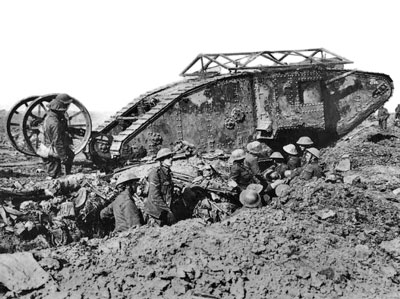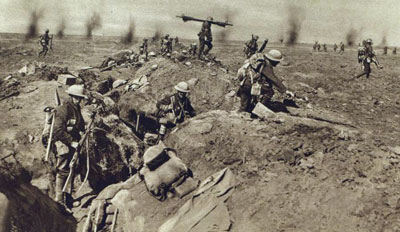
WWII: Maginot Line | Normandy | V-Weapon Sites | Arnhem
Further afield: Crete
| Home Tracing Military Ancestors Travel Advice CWGC Cemeteries Iron Harvest News Book Reviews Glossary Links Contact Me The Somme:
 
|
Enter the Tank: Flers-Courcelette and MorvalFrom mid-August Rawlinson, backed by Haig, had been planning an all-out advance alongside the French. Now with the high ground secure between Pozières and Guillemont (with the exception of High Wood), the next phase of the offensive could be realised. Rawlinson's initial plan seemed to Haig to be a return to the "bite and hold" tactics, which had caused such grievous casualties in the past two months, and he threw them out. Instead Haig proposed a massive dawn attack on 15th September 1916 concentrated between Courcelette and Flers and delivered by no less than five army corps, including New Zealand and Canadian infantry, backed by five cavalry divisions to exploit the expected breakthrough. The French Sixth Army would advance a day later to support the British right flank. Haig hoped that the attack would be driven home by a new weapon of war, which was to make its debut on the battlefield – the tank. Promoted by the efforts of Winston Churchill no less, and given the code name "tank" due to its resemblance to a water tank, fifty of these armoured vehicles were to be unleashed on the German defences.
The Germans, meanwhile, had not been idle. Whilst the British had been struggling to break into and secure the German second line, a new defensive system had been constructed to bar the way to Bapaume. New communication trenches were dug in a "wavy" pattern rather than "zig-zag" to speed reinforcement, whilst all trenches received fire-steps to bring maximum rifles to bear on the attackers. A three-day bombardment of nearly a million shells preceded the British offensive but delivered across a broader front, it lacked the concentration of the Night Attack. At 0620 hours on 15th September the tanks clanked forward with their accompanying infantry behind a creeping barrage. Although a number of tanks succumbed to mechanical failure and ditched prior to even reaching the start point of the attack, enough remained to cause a certain degree of panic amongst the German defenders. The villages of Courcelette, Martinpuich and Flers all fell to the tank advance and some machines managed to make it as far as Gueudecourt, Lesboeufs and Morval – a distance of almost two miles in places and the greatest advance of the battle thus far. Yet even as the success of the tank was being trumpeted, their limitations were also becoming clear. As well as still being mechanically unreliable, the armoured vehicles were prone to ditching and once through the German defences became isolated and vulnerable to German artillery fire over open sites. Further, the gaps left in the creeping barrage for the tanks to advance made the infantry following in their wake very vulnerable. Until their reliability could be improved and suitable tank-infantry-artillery tactics established, the tank was not the panacea for breaking the trench deadlock that everyone had initially believed. The real story of the Battle of Flers-Courcelette was not the grand entrance of the tank as a war-winning weapon – their time was still to come in 1917 and 1918, but the ultimate confirmation of the artillery as the primary arm in the era of trench warfare. All other arms were now subservient to the destructive power of the big guns. Infantry tactics were also slowly evolving with the use of Lewis light machine guns to provide local machine-gun fire support at section level, and the Royal Flying Corps was becoming more skilled at spotting targets for the artillery. However, other problems that had bedevilled the British since 1st July and before were also still present. The ground churned up by the heavy bombardment meant that field artillery could not get forward fast enough to support subsequent attacks. The flanks of the advance remained weak and, whilst most of the German defences in the battle zone had been pulverised, German batteries beyond remained unmolested and able to pour defensive artillery fire onto the waves of British and Dominion infantry. Casualties remained heavy – an estimated 30,000 on 15th September alone with the 47th (London) Division losing 4,700 men to finally capture High Wood. Above all, whilst the German defences had stretched, they still held – the vaunted breakthrough remained as elusive as ever.
Haig and Rawlinson wanted to follow up the advance but on the evening of the 15th September rain set in and it was not until the 25th that operations could continue. This time at Morval, tactics were modified again. Tanks were used but the infantry of XIV Corps advanced first behind a continuous creeping barrage far more concentrated than that on the 15th September. The German defenders were stunned and then smashed. The villages of Guedencourt and Lesboeufs, which was attacked jointly by the British and French, fell the following day. Gradually, the British Army was learning how to fight and win in trench warfare – a fact that was being underlined at that very moment a few miles away at Thiepval. |

